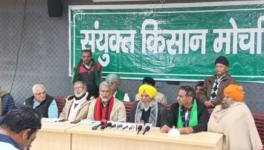COVID-19 Lockdown: Why Compensation to Workers is Overdue in India
The trade unions in India are demanding an ex gratia cash transfer of Rs 7,500 per month to all the workers outside the direct income tax bracket as compensation for income lost for the months the country was under the lockdown. The government is yet to respond to this extremely important demand as the exchequer is suffering from a huge revenue shortfall due to the COVID-19 induced lockdown.
The demand for an ex gratia cash transfer is absolutely legitimate in a democracy as the lockdown was imposed by the government and the poor workers suffered a huge income loss. On the other hand, the fiscal cost of this cash transfer for at least three months would be around Rs 10 lakh crore or close to five per cent of India’s GDP of 2019-10. This is the essential dilemma.
The periodic labour force survey (PLFS) data of 2018-19 reveals that more than half (52%) of our workforce is self-employed. The remaining, those who are employed are either regular salaried/wage employees (24%) or casual labourers (24%). The weighted average monthly income of the rural, urban, male, female workers in these three categories were Rs10,648, Rs 16,196 and Rs 7,566, respectively, during the months of April, May and June in 2019.
Therefore, if the workers have to be compensated for their income loss during the months between April and June this year, even according to the average wage rates of the casual labourers, it should be at least Rs 7,500 per month. In fact, most of the workers, particularly those in the unorganised sectors, have lost their jobs for more than six months due to the lockdown.
Source: PLFS Report 2018-19.
Note: Monthly earning during April-June 2019.
As far as the minimum wage norms are concerned, the C hief Labour Commissioner (Central), Ministry of Labour and Employment, Government of India had issued an office order dated October 12, 2020. According to this order, the minimum wage for unskilled workers should be at least Rs 368 per day (for agricultural sector) in rural areas. For the industrial workers, this has been set at Rs 427 per day in urban India.
If we assume 25 working days in a month, these are equivalent to Rs 9,200 and Rs 10,675 per month, respectively. Even if the government wishes to pay compensation according to its own minimum wage norms, it has to pay around Rs ten thousand per worker per month. Even if we deduct the price of free food-grains that were distributed as part of the Pradhan Mantri Garib Kalyan Yojana (for a family of four) the compensation should be at least Rs 8,500 in the rural areas and Rs 9,800 per month in urban India. The trade union demand of Rs 7,500 per month is in fact less than that.
As far as the situation of the exchequer of the Union Government is concerned, it is indeed in bad shape. According to the Controller General of Accounts, Ministry of Finance, Government of India, 42% of the annual revenue receipts accrued within the first half of last financial year 2019-20. As compared to that, only 27% could be raised in the current fiscal year within the first six months from April to September, 2020. Whereas 53% of total expenditures was incurred during the first half of last year, around 49% has been incurred this year. However, because of the huge revenue shortfall, the fiscal deficit already has become 115% (of what was budgeted for the entire year) within the first 6 months of the current year 2020-21. However, this is an exceptional pandemic year not only for India but for the whole world. Fearing a higher fiscal deficit, the government is not feeling confident in announcing any large-scale cash-transfer scheme while realising the need for it and even after understanding the feasibility of its implementation on the ground.
We have conducted a telephonic survey among workers in 13 states in India (and a primary survey in Goa) after the lockdown to understand the ground reality. It is evident that half of the families have become heavily indebted due to the lockdown as their income suffered badly but, expenditure could not come down, in general.
The rest of the households could somehow cope up with their past savings, however, for many of them it is almost or fully exhausted. Most of them are demanding some cash transfer and the majority of them are of the opinion that the lockdown has been more harmful and less beneficial in India. The government should at least acknowledge the suffering of the poor workers in the country due to their increased indebtedness and substantial depletion of past savings as a result of severe income loss for more than six months caused by the lockdown.
The government has two choices – either it provides some relief to the workers and agricultural labourers of the country by making a cash transfer of Rs 7,500 per month at least for three months under this recessionary situation or to restrict its fiscal deficit within the fiscal responsibility and budget management (FRBM) norms. If the government makes the required cash-transfers and incurs a larger fiscal deficit now and finances it by borrowing from the central bank (RBI), the economy would get a much needed demand-side push for a faster recovery. As the cash transfer takes place, aggregate demand would rise and the government revenue would also be buoyant. Aggregate level of employment would rise and the GDP growth would revive, and as a result of that the fiscal deficit to GDP ratio would automatically come down in the near future.
Therefore, the trade union demand for cash-transfer would not only provide relief to the vast majority of the working-class population, it would also help in reviving growth, level of employment and in managing the exchequer. It would act as a fiscal stimulus for the required demand injection into the economy. The government may wish to write off the loans of common people (at least partially) and incur debt vis-à-vis its own central bank in order to enhance the purchasing power of around 45 crore Indian workers. If the government does not do that, it would take a long time for the economy to revive and the unemployment rate to reduce and the common masses would suffer in an unprecedented manner. The revenue shortfall would rise further as a result of lower income, lower purchasing power of people and lower profit rates. The GDP growth rate would remain low or negative and the fiscal deficit as a proportion of the GDP would increase further in the future. Therefore, from the point of view of macroeconomic policy, the first strategy of an expansionary fiscal stance is always better under this crisis.
The foreign exchange reserves of the Reserve Bank of India are more than Rs 42 lakh crore or around 21% of the GDP (of 2019-20) as on November 6, 2020. Therefore, the RBI is in a comfortable position to lend five per cent of the GDP to the government for the much-needed cash-transfer to provide the necessary demand-side push to the economy and also to provide some relief to the vast majority of the working-class population (excepting the relatively well-off direct tax payee group) in the country.
Borrowing from the central bank would not cause a demand-pull inflation under a demand constrained situation. The democratically elected government must respond to the demands of the workers’ unions of our own country at the earliest. The government should at least acknowledge the fact that the lockdown compensation for the income loss of the working-class population in the country is indeed overdue.
The writer is assistant professor, Centre for Economic Studies and Planning, Jawaharlal Nehru University, Delhi. The views are personal.
Get the latest reports & analysis with people's perspective on Protests, movements & deep analytical videos, discussions of the current affairs in your Telegram app. Subscribe to NewsClick's Telegram channel & get Real-Time updates on stories, as they get published on our website.
























